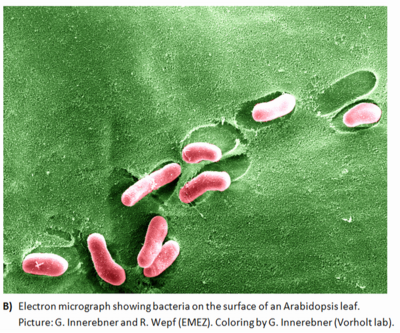Microbial corrosion
Introduction
The [phyllosphere] refers to the above-ground surfaces of a plant as a habitat for microorganisms, with a heavy emphasis on leaf surfaces. All plants are home to a wide variety of microorganism communities including bacteria, fungi, and yeasts. Some microorganisms benefit the plant, others are plant pathogens and can potentially damage or kill the host plant (4). The majority of bacterial colonists on any given plant have no noticeable effect on plant growth or function.
Estimates suggest that the roughly 1 billion square kilometers of worldwide leaf surfaces host more than 10^26 bacteria, which are the most abundant colonizers of this habitat. Overall, microbiota in this ecosystem are large enough to have an impact on both global carbon and nitrogen cycles. Further more the phyllosphere mircroorganisms influence their hosts at the level of the individual plants.
With repeated and rapid constant change of environmental conditions occurring on leaf surfaces, the phyllosphere is recognized as a hostile environment to bacteria. Leaf surfaces are often dry and temperatures can reach 40–55°C under intense sunlight. During the night, however, leaves are frequently wet with dew and at cool temperatures (5–10°C) (2).
Microbes that live in the Phyllosphere are called [Epiphytes]
Associated taxa
Mechanisms of action
Microbial uses
Effects on materials
References
(1) Lindow, S. Brandl, M. 2003. "Microbiology of the Phyllosphere." Applied and Environmental Microbiology. Vol. 69, No.4. 0099-2240
(2) Delmonte, N., Knief, C., Chaffron, S., 2009. "Community proteogenomics reveals insights into the physiology of phyllosphere." National Academy of Sciences.
(3) Machowicz-Stefaniak, Z., Krol, E. 2006. "Biotic effect of caraway phyllosphere fungi on the pathogenic fungus." Department of Plant Pathology University of Life Science. 2-8
(4)Suslow, T. 2005. "Microbial Food Safety IS Your Responsibility." Vegetable Research Information Center. 1-6.
(5) Howplantswork. 2009. "Life in the Phyllosphere: What Microbes Commonly Dwell on the Surface of Leaves?."
(6) Whipps, J.M. Hand, P. Pink, D. 2008. "Phyllosphere microbiology with special reference to diversity and plant genotype." 2-34
(7) Gardener, B., Frafel, D. 2002. "Biological Control of Plant Pathogens: Research, Commercialization, and Application in the USA." Plant Health Progress. 1-18
(8) Abell, G., Richter, A. 2008. "Nitrogen fixation by phyllosphere bacteria associated with higher plants and their colonizing epiphytes of a tropical lowland rainforest of Costa Rica." The IMSE journal. 2, 561–570
Edited by student of Angela Kent at the University of Illinois at Urbana-Champaign.

